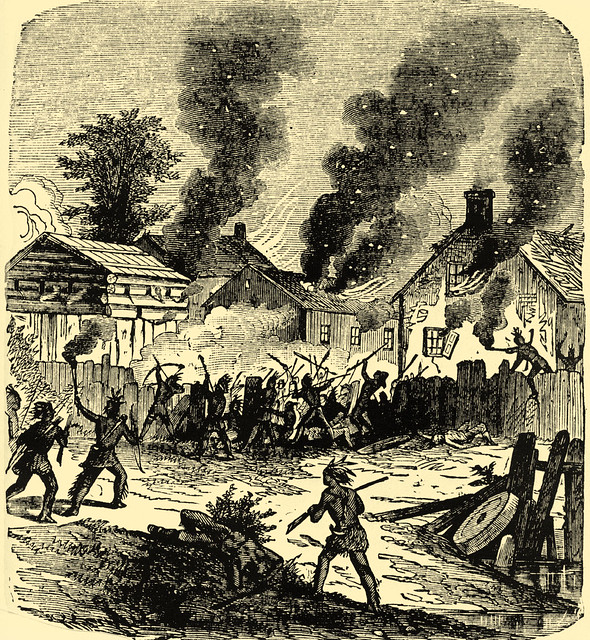
King Philip's War (1675-76) was a reaction by Native Americans to incursions of the Puritans. Charles Hudson, in A History of Marlborough, wrote:
"The horrors and devastation of Philip's war have no parallel in our history. The Revolution was a struggle for freedom; the contest with Philip was for existence. The war lasted only about fourteen months; and yet the towns of Brookfield, Lancaster, Marlborough, Medfield, Sudbury, Groton, Deerfield, Hatfield, Hadley, Northfield, Springfield, Weymouth, Chelmsford, Andover, Scituate, Bridgewater, Plymouth, and several other places were wholly or partially destroyed, and many of the inhabitants were massacred or carried into captivity. During this short period, six hundred of our brave men, the flower and strength of the Colony, had fallen, and six hundred dwelling houses were consumed. Every eleventh family was houseless, and every eleventh soldier had sunk to his grave."
Captain Edward Hutchinson, my ninth-great-grandfather, was mortally wounded in action in King Philip's War. He was chief officer of cavalry with the Massachusetts forces when attacked by Indian forces near Wickabaug Pond, West Brookfield, Mass. He died at Marlboro, Aug. 19, 1675.
I may also have had an eighth-great-grandfather, who would be my only traceable Native American blood so far in my family tree, Chief Gasessett of the Narragansett tribe, involved in King Philip's War. It is said by some sources that he died in battle in that war at the hands of the Mohegans (the tribe immortalized by James Fenimore Cooper's novels, especially, The Last of the Mohicans).
The Mohegans were allied with the Colonists at this time; the Narragansetts fought with King Philip. The would mean I had ancestors fighting against each other in the war.
Gasessett, who may also have been known as Minnetinka, may have died December 19, 1675, in the Great Swamp Fight, a preemptive attack by the Colonists that massacred many Narragansetts, including old men, women, and children. Though some warriors were also slain, many escaped.
The sachem's daughter, perhaps known as Minnetinka Gasessett after her father, narrowly avoided death. It is said she was taken in by a Quaker family and renamed Elizabeth.
The next part of the story we are certain of. She married my ancestor John Corey, Sr. in 1678/9 in Portsmouth, Newport Co., RI. They became my seventh-great-grandparents. Their son John Corey, Jr., became my sixth-great-grandfather. The Corey line descended from here directly to my mother, Rose Adelaide Corey. John, Sr., was the oldest of the 10 children of William and Mary Earle Corey. John and Elizabeth lived their entire lives in Rhode Island.
King Philip's War was costly to all, but in the long range, far more to the Indian tribes: "The war, which was extremely costly to the colonists in people and money, resulted in the virtual extermination of tribal Native American life in S New England and the disappearance of the fur trade. The New England Confederation then had the way completely clear for white settlement." (InfoPlease.com)
Illustration is in public domain.